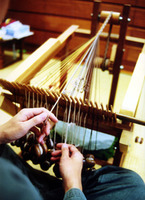

Total:131items
- Pottery & Porcelain (18)
- Lacquerware (4)
- Glasswork (2)
- Wood & Bamboo Work (19)
- Leather Work (1)
- Papermaking (13)
- Textile (20)
- Dyeing products (5)
- Masonry (1)
- Metal Work (11)
- Stationery (4)
- Livingware (3)
- Accessory (4)
- Toys & Entertainment (14)
- Interior (2)
- Other crafts (10)

 |
Main Production Site:Chiba |
 《Characteristics》
《Characteristics》You can see the history of Kumihimo (braided cords) starting from the earthenware in the Jomon Period (Jomon means “rope patterns” , 14,000BC-300BC). The technique had improved with the development of civilization and evolution and Kumihimo developed into a form like Kyo-Kumihimo which shows the cultural elegance of the Kyoto dynasty during the Heian Period (8-12c). In Kamakura Period (12-14c), it's usage as an item of armor led to the improvement of practical Kumihimo producing technique. In Edo Period (17-19c), Haorihimo (cords for Haori coats) production started. Kumihimo is made by braiding silk strands with beautiful lustre and finished from one of 3,500 braiding methods. Nowadays it is still being used in a variety of ways.
[Chiba Prefecture Designated Traditional Craft]
Information by: Kabushiki Kaisha Mr. Masa Nakamura
Translation by: Chan Yitin, reviewed by Yoshiko Nagao

| Materials | Silk strands |
|---|---|
| Crafting Processes | [Kumihimo Processing]
1) Mujizome (plain dyeing), Obijime (binding by cords) 2) Dyeing 3) Measuring 4) Braiding 5) Cutting tassel, Cutting tassel attaching (Kirifusa) 6) Finishing [About the interlacing frame] Round stand (Maru-dai) Mainly used to form round or flat cords by braiding downwards. Leash-rod stand (Ayatake-dai) Used for thin and flat braids and braid like weaving. Mainly used for braiding Obi (Kimono belt) bands or Haori (coat for Kimono) cords. Naiki stand (Naiki-dai) With its loud "gacha-gacha” noise when braiding, it is also called “Gacha” stand. Square stand (Kaku-dai) Named as square stand because of its mirror part (upper board) being square. It is mainly used for braiding upwards. High stand (Taka-dai) Can be used to braid complex patterns. Kumihimo with words imbedded and multiple patterns connected together to form a picture can also be done. There are some stands that can braid with 200 wheels. |
| History | Himo (cords) has a very long history. Two-stranded ropes or three or more stranded ropes with rotating patterns were stamped on the Jomon (which means “rope patterns” , 14,000BC-300BC) earthenware.
In Nara Period (8c), Kumihimo technique was imported with Buddhism from the continent and was used in scriptures and Kesa (a kind of costume of Buddhist monks). A musical instrument named “Kugo” (harp) in Nara’s Shosoin (the treasure house, which has a great collection of national treasures) is decorated with ancient Himo. In Heian Period (8-12c), Kumihimo was indispensable to noble costumes especially Kuo-obi (belt) known for its artistry. In the Kamakura Period (12-14c), Kumihimo was widely used as an item of soldier's armor. Kumihimo then expanded its usage as a decoration for tea utensils during the Muromachi (14-16c) period. During the Civil War Period (15-16c), Kumihimo was applied in armor Odoshiito (leather strap binding the plate of traditional Japanese armor). The demand of Kumihimo sharply increased due to its use for decoration of sword boxes in the Edo period (17-19c). Therefore, craftsmen of weapon accessories by nature started to live in Edo area under the protection of the shogunate government. Craftsmen competed with each other and created many new braiding methods. At that time, Kumihimo was used as kimono accessories, medicine cases, and cigarette cases. In Meiji Period (19-20c), the use of Kumihimo declined since the sword prohibition. However, due to the spread of wearing traditional Japanese clothing, the use of Kumihimo gradually recovered and attracted the interest of the Japanese again in the year 35 in the Meiji Period. Since then the popularity of Kumihimo still stands today. |
| Related URL | http://www.nakamurasho.co.jp/pc/index.html |
◆Event Information
Show window Gallery 2014
〒260-0015
1-11-11, Fujimi, Chuo-ku, Chiba-shi, Chiba Prefecture
Keiyo Bank Head branch Show window exhibition



